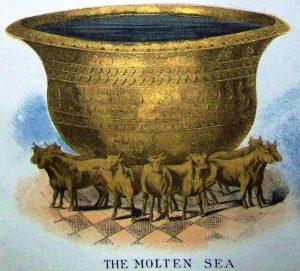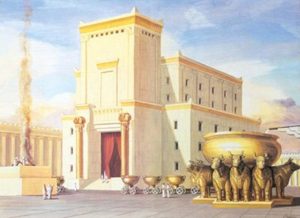Lessons Learned from Solomon’s Temple
1 Kings 7:23
Introduction.
One of the neat things I miss about teaching in a STEM field is all the quirky holidays.
A couple years ago, you might recall Mole Day (Oct. 23) happened upon a Wednesday and we talked about really big numbers.
Today happens to be Pi (π) Day.
No, people in STEM fields don’t celebrate apple pie or lemon meringue today—though I did feed a class some mini-pies one year.
No, this is the Greek letter “pi.”
You might remember this from your school days as 3.14, but it is an irrational number which means the decimals go on forever and don’t repeat.
All I have memorized is five decimal places: 3.14159.
And so that’s why it’s today, March 14th.
 What is π? It is the ratio of a circle’s circumference to its diameter (π = C/d).
What is π? It is the ratio of a circle’s circumference to its diameter (π = C/d).Basically what this means is that the path around a circle is a little over three times the distance from one edge to the other.
But did you know that pi is in the Bible?
Oh indeed, this ratio shows up when King Solomon is building the temple (1 Kings 7:23).
One of the pieces of architecture in the temple area, the Sea, was a large bronze basin that held water for the various cleansing rituals the priests had to perform.
Since a cubit is about 18 inches, the Sea was 7.5 feet high with a diameter of 15 feet.
The circumference is also mentioned at 45 feet.
Doing a quick calculation, you’ll find that 45 divided by 15, or 30 cubits divided by 10 cubits, is 3.
So the Bible gives a value of π to be 3.
The skeptic will say this shows the Bible is not inspired since we now know π is not simply 3.
At the same time, ancient peoples of the time knew it was a little more than 3 as well.
But the skeptic misses quite a lot about this passage and the brilliance of the temple’s construction, missing the forest for the trees.
So we will look at that forest, and maybe even address some of the trees.
Preview.
Planning & Preparation.
Pi’s Place.
Purpose.
Body.
Planning & Preparation.
It started with David.
Before the temple, the Israelites had a tabernacle to use for worship.
It was a mobile unit, basically a fancy tent.
It was utilitarian in the sense that it was built while the Israelites were wandering in the desert, making their way to the Promised Land.
But the Israelites had been in Canaan, in this Promised Land, for about 400 years when David took the throne.
David, a man after God’s own heart, thought it was time to build a permanent location to worship the one true God (2 Sam. 7).
And who could blame him? The nations around them had permanent temples to their false gods. The true and Almighty God deserved something even greater.
But what does the Lord say? He basically says, “I never asked for that.”
Then He adds, “Your son is going to build a house for Me.”
Reading the narrative of 2 Samuel and 1 Kings, it seems as though David left it at that, but 1 Chronicles records much more.
David plans for the temple (1 Chron. 23–26; 28:11-19).
Solomon often gets credit for building the temple and all that went into it.
But we often forget that it was David who took the time to appoint those of the Levites who would work in the temple, giving them their duties in anticipation of the temple being built.
He knew he wouldn’t be able to build it, but he wanted to do all he could to help his son build it.
Solomon didn’t even plan the temple, but David did. And David did so by the Holy Spirit (1 Chron. 28:11-13).
It was well-planned and well-executed, as we’ll see with Solomon.
Solomon executes the plan.
By the time Solomon becomes king, he already has a monumental task for one so young, so he asks for wisdom of the Lord.
He grants it and Solomon gets to work, spending 3 chapters in 1 Kings and 3 in 2 Chronicles building the temple.
He gets the craftsmen and the materials to carry out his father’s plans.
He gets the best of the best that’s available to him, and the temple he builds is magnificent!
It was so magnificent that those who saw that first temple wept when they saw the second, likely because it didn’t match the glory of the first (Ezra 3:13-14).
If David and Solomon took such care to plan for and build the temple of God, what care ought we to take with our bodies and with His church?
They got their instructions from the Holy Spirit, as did we from the Scriptures.
They sacrificed a lot of time and effort to get this time—God was worth their best.
Truly serving God will take a great deal of our time and effort—He is worth our best!
Through it all, Solomon also made the large laver, known as the Sea, to the specifications no doubt given him by his father from the Holy Spirit.
Pi’s Place.
The Holy Spirit’s instructions.
The instructions to build the temple were quite precise.
They don’t appear to be as precise as the instructions we see during the construction of the tabernacle in the latter chapters of Exodus.
But that doesn’t mean the plans Solomon had before him weren’t detailed.
It could be that what we have recorded is only a portion of the full plans.
That being said, it is still quite a remarkable feat of engineering.
To explain why π seems to be a little off, let us consider some possible solutions.
And there are a couple different solutions as to why that is.
Having a number of different possibilities isn’t a weakness but a strength!
Since any one (or a combination) of them could be true, it shows how unreasonable the skeptics’ are when they question the Scriptures.
It can also build our faith so that we are not deterred by little things like this.
One possibility lay with the brim.
Some conclude that it was the brim that measured 10 cubits across, and the circumference around the main section below the brim that measured 30 cubits.
Since the brim was a handbreadth thick (1 Kgs 7:26), which was about 3 or 4 inches, then that would account for the difference of 31.4 cubits at the brim and 30 cubits below it.
We should also recognize that an approximation is sufficient.
Consider, when you have diameter of 10 cubits, you would get a circumference of about 31.4 cubits.
And when you round 31.4 to one significant figure, what do you get?
Well, you get 30 cubits, which is exactly what the Bible records.
Since we have 10 cubits for the diameter, we only have one sig fig.
So, from 10 cubits, you’re going to get 30.
It’s a decent approximation, and should suffice as recorded in Scripture.
So what was the purpose of this temple structure?
Purpose.
 To provide God a house (1 Kgs 8:12-13).
To provide God a house (1 Kgs 8:12-13).This is a peculiar thing to say, since God doesn’t need a house to live in, as Stephen says when he quotes from Isaiah 66 (Acts 7:48-50).
The false gods of the day lived in the temples that were built for them and needed to be served by their worshipers.
The true God, however, lives in heaven and doesn’t need anything from us!
We serve Him not because He needs us to serve Him, but because we want to serve Him.
So then what kind of house is this?
This isn’t a house for God to literally live in, but for a representation of His glory to remain for a short time, as we see it descending upon the temple when it was dedicated (1 Kgs 8:10-11).
The Israelites now had a fixed central location for them to come to honor and worship the Lord, to make sacrifices and to have their sins absolved.
What the skeptic misses when he focuses on some of these granular details is the greater picture—that they built this magnificent temple to properly serve God.
They forget that this is structure is rather unique compared to those made to honor false gods, which indicates to us that it did not originate in the mind of man.
This confirms what we read before, that it was from the Holy Spirit.
A great part of their worship was the prayers that they offered, especially concerning Solomon’s prayer later in 1 Kings 8.
That the Lord might hear their prayers (1 Kgs 8:28-30).
Direction. Solomon prayed for wisdom when dealing with tough cases. Similarly, we are often in situations where we have no clue which way to turn. Let us ask the Lord for direction!
Repentance. We’ve spent a good deal of time on repentance last month, but prayer is a big part of it. Let us offer our prayers to God when we repent of our sins so that we might be forgiven.
Prayers of all people. Solomon wanted all people to be able to make use of the temple. Even Jesus called the temple, quoting from Isaiah, “a house of prayer for all nations” (Mark 11:17; Isa. 56:7). God is a God of all, and the gospel today is meant for all.
Campaigns. Solomon prayed for help during battle. Out battle is against sin, against Satan, and for souls. Let us pray when it comes to our battles against these things, and so that we might be better soul-winners.
Let us provide God a house (1 Cor. 6:19-20).
Our body is a temple of the Holy Spirit.
Just as He did not literally live in the temple of Solomon, He does not literally live in us.
But He does dwell in us as He dwelt in the temple of Solomon.
What exactly that means, it’s hard to say—some say it’s through the Word, and that is certainly an element of it.
All I know is that through our bodies, we are to honor and worship God, offering ourselves as a living sacrifice, holy, acceptable to God, which is our reasonable service (Rom. 12:1).
And through this reasonable service, we are to make ourselves comfortable for the Holy Spirit to dwell.
We are not to grieve the Holy Spirit with sin (Eph. 4:30).
Instead, we are to flee from sin, while living a righteous and holy life.
That doesn’t mean we’re going to be perfect, but it does mean we are working on it.
Your body is a temple of God—live like it!
Conclusion.
This is what the skeptic misses when he concentrates on trivialities that he thinks proves his point.
Yes, π is a special number, a constant that is a fundamental law of nature.
But who do you think invented it?
Why, it’s God Himself, the One we ought to be worshiping with our bodies, our temples of the Holy Spirit!
The way we can do that most effectively is if we …
Plan to give our best to God.
Actually give our best to God.
Keep ourselves from sin.
But there’s one thing we all have to do first: become a Christian.
Will you prepare your body to be that temple of the Holy Spirit?
Will you follow Him?


